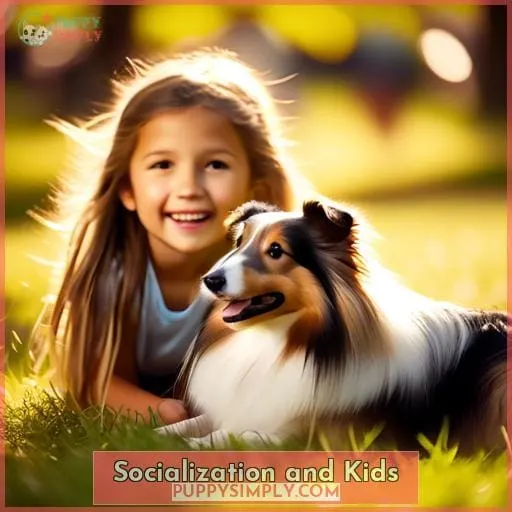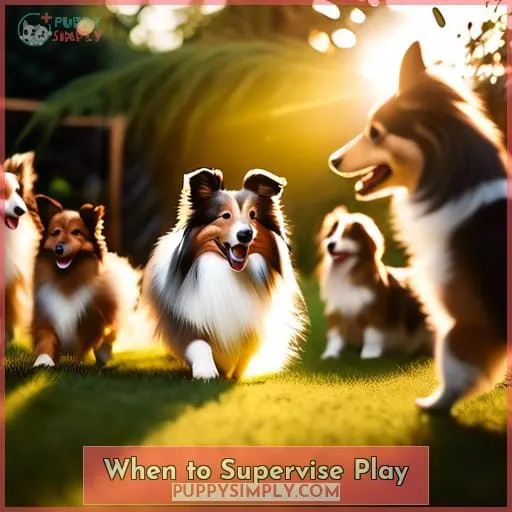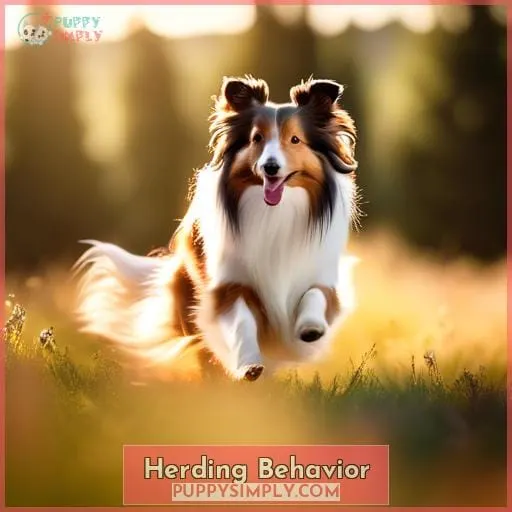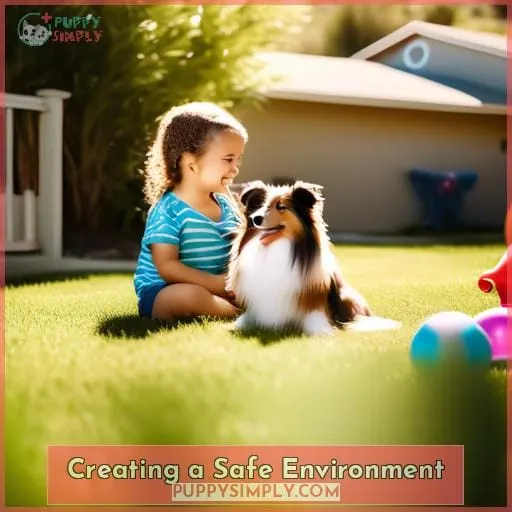This site is supported by our readers. We may earn a commission, at no cost to you, if you purchase through links.

As a veterinarian who has treated countless shelties, I can tell you they’re wonderful with children.
Their affectionate nature makes them ideal playmates.
However, supervision is key, as herding instincts can lead to nipping.
With socialization and training, shelties and kids can build beautiful bonds.
Their loyalty and warmth shines through when respected.
Give them structure, and shelties become the perfect canine companion for little ones.
Table Of Contents
Key Takeaways
- Gentle and loyal, Shetland Sheepdogs (shelties) can make great family dogs with proper socialization and supervision around children.
- Focus on matching Shetland Sheepdog temperament to household, not gender; meet parents first.
- Create a safe environment via rules, boundaries, calm correction; teach kids gentle interaction.
- Select an easygoing Shetland Sheepdog; help excitable dogs settle through breaks, positive reinforcement.
Sheltie Temperament and Kids
As a veterinarian with decades of experience, I understand your concern about how shelties interact with children.
Let’s discuss their gentle, sweet nature and their playful, affectionate temperament that tends to delight kids of all ages.
We’ll go over some key points about why shelties make great family dogs for homes with young ones:
- Their gentle, sweet nature makes them ideal companions for children.
- Their playful, affectionate temperament delights kids of all ages.
- They are intelligent and easy to train, making them a good choice for families with children.
- They are relatively small, making them easy for children to handle.
- They are generally healthy and have a long lifespan, making them a long-term commitment for families.
Gentle and Sweet Nature
Consider a Sheltie’s gentle and sweet nature when deciding if they’re a good fit for your kids:
- Loving temperament
- Friendly personality
- Loyal companion
Their sweet disposition, gentle demeanor, and affectionate nature make them an excellent kid-friendly breed.
Playful and Affectionate
Shelties are very playful and affectionate with kids.
Their lively, cheerful nature makes them enthusiastic playmates for children.
They eagerly seek out affection and attention from family members young and old.
ActivityProper InteractionsCommon Issues
Playful FunGentle petting, positive reinforcementPulling fur/tail, hitting
TrainingTeaching tricks, positive reinforcementYelling, punishment
ExerciseGames of fetch, running togetherKids moving too fast
Sheltie Energy and Playfulness
You’ll find that shelties have very high energy levels and absolutely love games and activities.
Their energetic, playful nature makes them wonderful companions for kids who enjoy running around.
However, their intense energy means they require plenty of daily exercise and mental stimulation.
High Energy Levels
Shelties have high energy levels and love games and activities.
- Play fetch and frisbee outdoors.
- Participate in agility courses.
- Learn new tricks indoors.
- Have a puzzle toy rotation.
With enough daily exercise and mental stimulation, their energetic nature makes Shelties fun and engaging companions for kids.
Love for Games and Activities
Shelties love participating in games and activities with kids. As high-energy dogs, they enjoy outlets for play.
Take your Sheltie on:
- Family outings
- Adventures outdoors
- Indoor games
- Interactive toys
Train tricks together:
- Shake
- Roll over
- Play dead
- Spin
- Weave
Outdoor adventures:
- Hiking
- Swimming
- Fetch
- Frisbee
- Agility courses
Indoor games:
- Hide-and-seek
- Tug-of-war
- Find the treat
- Nose work
- Treasure hunts
Training tricks:
- Shake
- Roll over
- Play dead
- Spin
- Weave
Training and Intelligence
As notably eager to please dogs, Shelties excel in obedience training and canine athletics like agility courses.
Their exceptional responsiveness to commands and positive reinforcement makes them a delight to train.
With proper socialization, this high degree of trainability allows Shelties to become wonderfully mannered companions around children.
Eager to Please
Since Shelties are so eager to please their owners, you’ll find them highly trainable and exceptionally responsive when you engage them in obedience, agility, and herding.
These bright, quick learners make cooperative companions for families.
However, their kid-friendly personalities come with some mouthiness and wanderlust potential that require patient guidance.
Their eagerness makes them easy to train through positive reinforcement and moderate daily exercise.
Excel in Obedience and Agility
Their intelligence and eagerness to please make them excel in obedience and agility training, allowing you to engage them in fun activities.
| Activity | Description | Benefits |
|---|---|---|
| Obedience Trials | Performing various commands in a competition setting | Mental stimulation, bonding |
| Agility Courses | Navigating obstacles like tunnels, jumps, weave poles | Physical challenge, confidence building |
| Nose Work | Using scent to find hidden objects | Mental exercise, tapping into natural instincts |
They thrive learning new things and activities that tap into their working instincts.
Protective Instincts
Shelties have a deeply ingrained protective streak when it comes to their families.
They make excellent watchdogs and will readily sound the alarm if they sense danger or intruders, while remaining exceedingly gentle with children.
However, socialization is key to ensuring good behavior around unknown visitors.
Good Watchdogs
Your sheltie makes an excellent watchdog for your family members due to its alert, responsive nature and devotion to its family.
As herding dogs, shelties have strong protective instincts towards their flock that translate well into watchdog skills with proper Watchdog Training.
Perform regular Alertness Exercises to encourage attentiveness.
Though small, their Family Protection abilities stem from wariness of strangers combined with loyalty.
Reinforce Guard Dog Skills through rewards for alarm barking at unusual sights and sounds, as this deters intruders and enhances Home Security.
Protective of Family Members
Because of their protective instincts, Shelties guard and watch over family members, especially small children.
As loyal family dogs, Shelties use their alert nature and quick reflexes to keep children safe, demonstrating their dedication through protective behaviors.
However, these defensive reactions must be properly managed to prevent overguarding.
With training, Shelties can provide security and companionship without becoming overzealous guardians.
Socialization and Kids
Early socialization with children is key for shelties.
Make sure to gradually expose your sheltie to kids of different ages, so they become accustomed to children’s noises, movements, and scents.
This allows you to lay the foundation for safe interactions between your sheltie and any children they encounter.
Importance of Early Socialization
You’ll also need to properly socialize your Sheltie early on by gradually exposing them to children’s sights, sounds, and scents so they become comfortable interacting with kids.
- Allow supervised interactions with children.
- Use treats and praise to reward good behavior.
- Get kids involved in training.
- Take it slowly and watch for signs of stress.
- Make it a positive experience for the puppy.
Acclimating to Kids’ Presence
By introducing your Sheltie early to children’s voices, movements, and scents, you’re acclimating them to the unique energy of kids for smoother future interactions.
Through controlled, positive exposures, familiarize your pup to routines like story time or play.
Gently introduce and monitor, building trust so they feel safe when interacting.
Health Considerations
When considering a Sheltie, you’ll need to factor in some common health issues:
- Epilepsy
- Bleeding disorders
- Skin problems
These dogs also require regular brushing and combing to keep their lovely coats clean, along with occasional trimming.
However, overall Shelties are quite healthy dogs that make excellent, gentle companions for households with children when cared for properly.
Common Health Issues
Although shelties are typically healthy dogs, you’re wise to know about some health problems they can develop so you can get veterinary care when needed.
As herders, they require ample exercise and mental stimulation to stay healthy.
Monitor for issues like dermatitis, epilepsy, bleeding disorders, and joint problems.
Providing proper nutrition, grooming, exercise, and vet checkups will help prevent issues.
Grooming and Care Needs
Tending to your sheltie’s thick double coat requires:
- Regular brushing and combing
- Occasional trims to keep the feathering neat
Daily brushings:
- Remove dead hair before it tangles or mats
- Stimulate skin health
- Manage shedding
Regular grooming:
- Prevents painful mats
- Keeps their coat neat
- Gives you quality bonding time
Annual trims:
- Tidy feathering
- Prevent eye irritation
Making grooming a consistent routine:
- Enhances your bond through gentle handling and skin stimulation
When to Supervise Play
You’ll want to keep a close eye on your Sheltie when they interact with children.
If you notice signs of aggression or discomfort, be alert for behaviors like growling, snapping, cowering, or running away, as these suggest your Sheltie feels threatened.
Gently intervene if children get overly rambunctious, and consistently reinforce positive interactions to ensure safe play.
Signs of Aggression or Discomfort
When you’re supervising play between your sheltie and kids, watch for signs like growling, snapping, stiffening up, cowering, or hiding that signal discomfort or aggression.
Promote positive interactions by recognizing these subtle cues, calmly removing the dog from the situation, and reinforcing good behavior on both ends.
Clear communication and proper training ensure everyone’s safety while strengthening your family bond.
Ensuring Gentle Interaction
You’ll want to keep a close eye on kids’ interactions with your Sheltie to ensure gentle handling.
Guide children to be respectful and kind with communication, using calm encouragement and patience to build understanding.
Shelties thrive on affection, but may startle if handled roughly.
Teach gentle petting and play to make them feel safe.
Reiterate boundaries gently if needed.
Exercise and Mental Stimulation
As high energy herding dogs, Shelties need plenty of exercise and mental stimulation.
Engage your Sheltie in activities like agility, obedience training, or herding trials, which kids can participate in too.
Also, make sure to provide vigorous daily play sessions and walks to meet their needs for activity.
Keeping Shelties Busy
Having supervised play between Shelties and kids, you’ll want to provide enough exercise and mental stimulation to prevent boredom leading to destructive behaviors.
- Interactive toys like treat-dispensing puzzle games.
- Outdoor adventures like hiking, playing fetch.
- Obedience and agility training.
- Learning tricks and commands.
- Change-up toys and activities to keep things interesting.
Activities for Kids and Shelties
The activities you and your kids can enjoy with a Sheltie provide excellent exercise and mental stimulation for the dog.
Outdoor adventures like hiking, playing fetch, and exploring new sights and sounds are ideal.
Engage their herding instincts with games like hide-and-seek.
Training challenges build confidence and reinforce good behaviors.
Sensory boxes with textures, scents, and sounds pique their curiosity.
Simple indoor games and creative crafts like treat puzzles mentally stimulate them between outdoor romps.
Herding Behavior
You’ll need to understand their herding instincts and manage any nipping or chasing of little ones.
Shelties view moving children as stock to control, so set boundaries early and positively reinforce wanted behaviors.
We’ll delve into managing those herding behaviors next.
Understanding Herding Instincts
As herding dogs, Shelties have innate herding behaviors you’ll need to understand and manage, including nipping at heels and chasing movements.
Their instincts tell them to gather and direct creatures by nipping and circling.
Work on redirecting these deeply ingrained behaviors toward appropriate outlets.
Reward non-herding behaviors.
Provide alternative stimulation.
Managing Nipping and Chasing
Since Shelties have strong herding instincts, you’ll need to curb any nipping or chasing behavior directed at kids.
Redirect your dog’s focus through positive reinforcement and interactive play.
Set clear boundaries, use consistent training to establish what’s allowed and what isn’t.
Nipping and chasing should never be tolerated around children.
Stay vigilant and be prepared to intervene immediately.
With time and effort, you can curb these herding behaviors to keep both your Sheltie and kids safe.
Creating a Safe Environment
When bringing a sheltie into a home with children, it’s imperative you establish rules for the kids.
These rules should include how to approach, play with, and overall treat the dog respectfully.
Mishandling can elicit negative reactions from even the sweetest sheltie.
Setting Boundaries for Kids
You’ll need to establish clear rules for how kids should interact with your Sheltie to ensure everyone’s safety and happiness.
Set limits through open communication reinforced consistently.
Children must respect the dog’s boundaries:
- Moving slowly and gently
- No tail/ear pulling
- Reward gentle petting
Supervise all interactions, correcting kids firmly but calmly if needed.
Stress no hitting or teasing, only positive reinforcement.
Training Kids on How to Treat Dogs
Once boundaries have been set, you’ll want to continue creating a safe environment by training your kids on how to properly interact with and treat dogs.
Teach gentle petting and no pulling of fur or tails.
Use positive reinforcement to encourage respecting the dog’s boundaries.
Model appropriate play that’s gentle and doesn’t overwhelm the dog.
Frequently Asked Questions (FAQs)
What kinds of toys do shelties like to play with?
Shelties love playing fetch with soft toys like balls, st■ animals, and rubber chew toys.
Tug-of-war is another favorite as they can herd the toy.
Interactive puzzle feeders engage their problem-solving instincts.
Sticks, ropes, and hard plastic shouldn’t be used as Shelties may ingest pieces.
How do I introduce a new baby to my sheltie?
Slowly introduce baby sounds and scents prior to arrival.
Once home, have trusted family members engage positively with the dog first.
Then bring the baby into a calm, treat-filled room for a gentle, supervised meet.
Keep sessions brief and happy.
Is my sheltie too small/fragile to play with my kids?
I wouldn’t worry about your sheltie being too small or fragile for children.
Shelties are lively, sturdy little dogs.
Supervise play and teach the children how to interact appropriately.
A well-bred, healthy sheltie should have no issue keeping up.
Focus on positive reinforcement when they play gently.
Should I get a male or female sheltie for my family?
When selecting a sheltie for your family, focus less on gender and more on temperament.
Meet the parents when possible to assess the pup’s likely demeanor.
An easygoing female or male can thrive with children if properly socialized.
The right match hinges on personality, not parts.
How can I calm my sheltie down when he gets overexcited around the kids?
Stay calm and redirect your sheltie’s energy with a toy or command when he gets overexcited.
Reward him for settling down.
Set boundaries with the kids on proper interactions and give your dog breaks from play if needed.
Be vigilant about signs of overstimulation and intervene early.
Short, positive training sessions can help too.
Conclusion
Like a gentle shepherd guiding his flock, the Sheltie can lead your children into a beautiful friendship built on loyalty and warmth.
With some guidance from you, their guardian, these energetic pups will run and play with boundless affection.
Set fair rules for both child and canine, provide plenty of activities, and you’ll reap the rewards of this special bond for years to come.
















